Looking to savor a perfectly cooked rib-eye steak? Look no further! In this article, we’ll guide you through the art of cooking a rib-eye on a gas grill, ensuring juicy and tender results every time. Whether you’re a seasoned grill master or a novice in the world of cooking, we’ve got you covered with simple yet effective techniques that will elevate your grilling game. So, grab your apron and get ready to discover how to cook a rib-eye on a gas grill with confidence and deliciousness in each bite. Let’s get started!
How to Cook a Rib-Eye on a Gas Grill
Grilling a rib-eye steak on a gas grill is a delicious and satisfying way to enjoy a juicy and flavorful cut of meat. With the right techniques and a few key tips, you can master the art of cooking a perfect rib-eye every time. In this guide, we will walk you through the step-by-step process of grilling a rib-eye on a gas grill, from selecting the right steak to achieving a mouthwatering sear. So grab your apron and let’s get grilling!
Choosing the Perfect Rib-Eye Steak
The first step to cooking a delicious rib-eye on a gas grill is selecting the right steak. Here are some factors to consider when choosing your rib-eye:
1. Quality: Look for a steak with marbling, which refers to the streaks of fat running through the meat. Marbling enhances the flavor and tenderness of the steak.
2. Thickness: Opt for steaks that are at least 1 inch thick. Thicker steaks are easier to cook to the desired doneness without overcooking the outer layers.
3. Bone-in vs. Boneless: Rib-eye steaks are available in bone-in and boneless options. While bone-in steaks add extra flavor during the cooking process, boneless steaks offer easier handling.
Preparing the Rib-Eye Steak
Before you fire up the grill, it’s essential to prepare your rib-eye steak properly. Follow these steps to ensure a successful grilling experience:
1. Bring the steak to room temperature: Remove the rib-eye from the refrigerator and let it sit at room temperature for about 30 minutes. This helps the steak cook more evenly.
2. Season the steak: Generously season both sides of the steak with kosher salt and freshly ground black pepper. You can also add other dry rubs or spices to enhance the flavor, such as garlic powder, paprika, or rosemary.
3. Optional marinating: While rib-eye steaks are flavorful on their own, you can marinate the steak for added taste. Choose a marinade that complements the natural flavor of the beef, like a simple combination of olive oil, minced garlic, soy sauce, and Worcestershire sauce. Allow the steak to marinate in the refrigerator for at least 2 hours or up to 24 hours before grilling.
Preheating and Preparing the Gas Grill
To achieve a perfect rib-eye, it’s crucial to set up your gas grill correctly. Follow these steps for preheating and preparing the grill:
1. Clean the grates: Start by cleaning the grill grates thoroughly to ensure there are no leftover debris or residue from previous cookouts. Use a grill brush to scrape off any stuck-on food.
2. Preheat the grill: Preheat your gas grill to medium-high heat, around 400-450°F (204-232°C). Close the lid and let the grill heat up for approximately 10-15 minutes. This step helps to create a sear and prevents the steak from sticking to the grates.
3. Oil the grates: Once the grill is preheated, use tongs to dip a folded paper towel in vegetable oil. Rub the oiled paper towel over the grates to create a non-stick surface.
Grilling the Rib-Eye Steak
Now that your grill is preheated and ready, it’s time to grill the rib-eye steak to perfection:
1. Sear the steak: Place the rib-eye steak directly onto the preheated grill grates at a 45-degree angle. This creates beautiful grill marks. After 2-3 minutes, rotate the steak 90 degrees to create a crosshatch pattern and sear for an additional 2-3 minutes.
2. Flip and repeat: Using long-handled tongs, flip the steak over and repeat the searing process on the other side. This will give both sides of the steak an equally delicious crust. For medium-rare, cook the steak for about 6-8 minutes in total, or adjust the cooking time according to your desired level of doneness.
3. Check the internal temperature: To ensure the steak is cooked to your preference, use an instant-read meat thermometer to check the internal temperature. For medium-rare, the thermometer should read around 135°F (57°C). Remember that the steak’s temperature will continue to rise slightly after removing it from the grill.
4. Rest the steak: Once the steak reaches the desired temperature, remove it from the grill and transfer it to a cutting board. Allow the steak to rest for 5-10 minutes to allow the juices to redistribute throughout the meat, resulting in a juicy and flavorful bite.
Serving and Enjoying the Rib-Eye Steak
Now that your rib-eye is perfectly cooked, it’s time to serve and enjoy your masterpiece. Here are some tips for serving and enhancing the flavors:
1. Slice and plate: Slice the rib-eye against the grain into thin strips to maximize tenderness. Transfer the slices to a serving platter or individual plates.
2. Add finishing touches: For an extra touch of flavor, you can top your grilled rib-eye steak with a pat of compound butter, such as garlic herb butter or blue cheese butter. Allow the butter to melt slightly over the warm steak.
3. Pair with sides: Serve your rib-eye with a variety of delicious side dishes. Classic steakhouse sides like mashed potatoes, grilled vegetables, or a fresh salad make excellent accompaniments to enhance your meal.
4. Enjoy with your favorite beverage: Complete your rib-eye experience by pairing it with your favorite beverage. Whether it’s a full-bodied red wine, a craft beer, or a refreshing iced tea, choose a drink that complements the rich flavors of the steak.
Troubleshooting Common Issues
Sometimes, despite your best efforts, things may not go as planned. Here are some common issues that may occur while grilling a rib-eye and tips on how to troubleshoot them:
1. Steak sticking to the grill grates: If the steak sticks to the grates, avoid forceful flipping. Allow the steak to cook a bit longer, and it will naturally release from the grates once a crust forms.
2. Overcooking or undercooking: To avoid overcooking or undercooking, it’s essential to monitor the internal temperature of the steak using a meat thermometer. Adjust the cooking time accordingly to achieve your desired level of doneness.
3. Uneven cooking: Uneven cooking can occur if the steak is not at room temperature before grilling. Ensure that the steak is brought to room temperature before placing it on the grill.
4. Dry steak: To prevent a dry steak, avoid overcooking. Additionally, you can try marinating the steak before grilling to enhance moisture retention.
Grilling a rib-eye steak on a gas grill is a fantastic way to indulge in a juicy and flavorful meal. By following these step-by-step instructions, you’ll be well on your way to becoming a grill master. So fire up your gas grill, select a succulent rib-eye steak, and get ready to savor the deliciousness!
The Cheat Code to Reversed Seared RIBEYE Steaks on a GAS GRILL!
Frequently Asked Questions
How long should I preheat the grill before cooking a rib-eye?
Preheating the grill is an important step to ensure a perfectly cooked rib-eye. Start by preheating your gas grill for about 10-15 minutes on high heat. This allows the grill grates to reach the optimal temperature for searing and caramelizing the steak.
Should I marinate the rib-eye before grilling?
While marinating is not necessary, it can enhance the flavor of the rib-eye. You can marinate the steak for 30 minutes to a few hours in a mixture of your choice, such as a blend of olive oil, garlic, herbs, and spices. This can help tenderize the meat and add extra flavor.
How do I season the rib-eye?
Seasoning your rib-eye is a crucial step to bring out its natural flavors. Start by generously sprinkling both sides of the steak with salt and black pepper. If desired, you can also add additional spices or herbs to complement your taste preferences.
What is the best cooking temperature for a rib-eye?
The ideal cooking temperature for a rib-eye on a gas grill is medium-high to high heat, around 400-450°F (204-232°C). This allows for a good sear on the outside while keeping the inside juicy and tender. Use a meat thermometer to ensure the internal temperature reaches your desired level of doneness.
How long should I cook a rib-eye on a gas grill?
Cooking times can vary depending on the thickness of the rib-eye and your desired level of doneness. As a general guideline, grill the rib-eye for 4-6 minutes per side for medium-rare, 6-8 minutes per side for medium, or 8-10 minutes per side for well-done. Remember to flip the steak only once during cooking.
Should I let the rib-eye rest before serving?
Yes, it is recommended to let the rib-eye rest for about 5-10 minutes after grilling. This allows the juices to redistribute within the meat, resulting in a more flavorful and tender steak. Tent the steak loosely with foil while it rests to retain heat.
Final Thoughts
To cook a rib-eye on a gas grill, start by preheating the grill to high heat. Season the rib-eye generously with salt, pepper, and any desired herbs or spices. Place the rib-eye on the hot grill and cook for approximately 4-5 minutes per side for medium-rare, adjusting the time based on desired level of doneness. Use a meat thermometer to ensure the internal temperature reaches 135°F (57°C) for medium-rare. Let the rib-eye rest for a few minutes before serving to allow the juices to redistribute. And there you have it, a perfectly cooked rib-eye on a gas grill!

